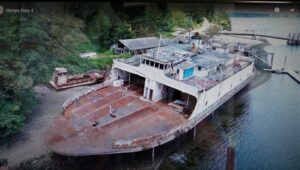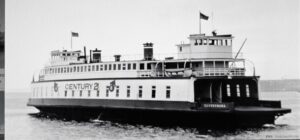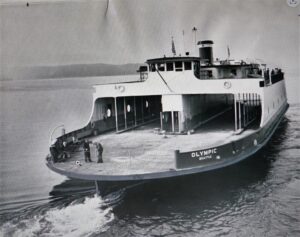We enjoy when our FB followers share their memories of living on Whidbey Island. Here’s a recent one by Dick Bryant with attached ferry photos…
A COUPLE OF OLD FERRIES
by Dick Bryant
As a resident of South Whidbey for the first 20 years of my life, I became quite familiar with the ferry system to and from the Island. This time period occurred through the end of the old Black Ball Line (Puget Sound Navigation Co.) era and the beginning of the Washington State Ferry System (WSF). Ferries were, and sill are, the life line between South Whidbey and the mainland.
A recent Facebook post about the Black Ball Line sparked my interest as to what ferries were on the Mukilteo/ Columbia Beach run while I was a regular rider.
The two boats I remember most were the Chetzemoka and the Olympic. I thought I would share a little history about those two old ferries, since I made many crossings on both.
CHETZEMOKA
The boat was built in the San Francisco Bay area in 1927, and was christened the Golden Poppy. Its run was across the Bay from San Francisco to Marin County. It ceased operation when the Golden Gate Bridge opened in 1937. The boat was purchased by the Black Ball Line and was transported to Puget Sound in 1938. She was refurbished, and renamed the Chetzemoka, in honor of a friendly Native American chief of the Klallam tribe from the Port Townsend area. The boat was put to work on the Port Townsend to Edmonds run from 1938 to 1947.
Then she was moved to the Mukilteo/Columbia Beach (now Clinton) route. She continued making this crossing up through the takeover of the Black Ball Line by the WSF in 1951. In 1954 the Olympic began to share this route.
The Olympic and Rhododendron had recently been purchased and brought to Puget Sound from the east coast. The Chetz and Oly shared this run for the next 7 years.
In 1961 the Rhodie was moved to the Mukilteo/Columbia Beach run and the Chetz was put into a reserve status. She continued to work various routes on weekends and during the summers. Her last season was 1973 and her last run was on Labor Day of that year.
Being a wooden boat she needed to be recaulked and dry rot was beginning to set in. This proved to be the end of the line for her. The old boat had made her last crossing. She was sold for $16,000 in 1975. A California investor planned to tow her back to the Bay Area, and turn her into a shopping center on the San Francisco waterfront. In the spring of 1977 while under tow, she encountered heavy seas, sprung a leak and sank in 235 feet of water 9 miles off the coast near LaPush.
OLYMPIC
The Olympic was the other boat I remember well. I started attending Everett Junior College in the fall of 1953. Lack of funds, and understanding parents allowed me to spend the 2 years at EJC living, at home, on the Island. I commuted, by ferry, every day through each school year. I spent a lot of time on the Olympic.
The Olympic was built in 1938 in Baltimore, MD. She plied the Chesapeake Bay until the Bay Bridge was built in 1953, at which time her and Rhododendron were towed to Puget Sound. WSF had taken over the ferry system, and were finding boats where they could. I guess the WSF was not set up, as yet, to build all the boats they needed.
The Oly started on the Lowfall/South Point run in 1954, but shortly was put on the Mukilteo/Columbia Beach route along with the Chetzemoka. When the Hood Canal Bridge opened in 1961, the Rhodie and the Oly both did the Mukilteo/Clinton crossing. This continued until 1969. She then did various routes and was supposed to retire in 1983, but continued on various routes until she finally was taken out of service in 1993.
An overhaul was planned, but was canceled due to expense. She was sold in 1997 for $71,000. The new owner planned to turn her into a tour boat and a museum. That plan never materialized and she began to deteriorate. There was some restoration done in 2006, and then in 2009 was put on eBay. It changed hands and was moved to Ketron Island and is now lying on the beach slowly rusting away.
There were several other boats that would occasionally make the Mukilteo/Clinton run during my time. Here are the ones I remember: Vashon, Bainbridge, Kitsap, Rhododendron, and Leschi. There may have been others that were on the run from time to time. It would be interesting if there was any history on these boats and what was their final disposition.
Many boats, past and present, have plied the Puget Sound waters over the years. Lots of boats were and are named after islands and other local geographic places. I always wondered why WA State Ferries never named one “Whidbey”. I think the Island got short-changed.
——————-
(Editorial note follows): Actually in the early days of car ferry service when it was privately owned, there were two ferries named Whidbey: Whidbey I and Whidbey II.
Two visionary men arrived in Clinton with the idea of starting a car ferry service. They became pioneers in the cross sound ferry service but also fierce rivals in the business that erupted into fistfights and court cases.
Captain Olaf Joyce came from Minnesota and started a purse seining business. He later added tugboats to his operations. He saw the automobile as the wave of the future. He, his brothers, and Captain H.B. Lovejoy formed the Whidby Island Transportation Company.
Willis Nearhoff, (originally from Indiana) came to Whidbey Island also with the idea of starting a car ferry service.
Joyce commissioned Nearhoff to build the Whidby I, a fifty-nine foot gas driven car ferry.
Nearhoff at the same time built his own carry ferry, the Central I. Both boats were similar and built at Columbia Beach. Nearhoff actually launched his boat on July 10, 1919, but did not put it into service until August 26, 1919.
Joyce’s car ferry, went into actual service on August 10,1919. It ran between Mukilteo and Phinney Beach about a mile below the present ferry dock. Phinney Beach is the site where Jim and John’s Resort was later built.
Nearhoff started service two weeks later running between Everett and Clinton. Nearhoff’s Clinton Dock was about a thousand feet south of the present ferry terminal.
Hard feelings developed between the two ferry operators. It came to a head when Captain FG Reeve bought controlling interest in the Whidbey Transportation Company.
He commissioned the Whidbey II to be built. It was a larger ferry that could carry twenty five to thirty five cars. It made the run between Clinton, Langley, and Everett. It was in direct competition with the Central I. The strain became so great between the two ferry lines that a fistfight erupted outside of the Progressive Hall in Clinton.



